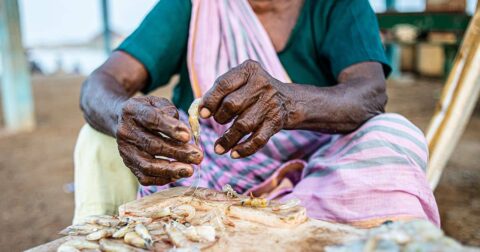Feature
Heat Exhaustion, Amputated Fingers, Crushed Limbs: The Hidden Cost of American Turkey
Food•8 min read
Reported
Much of the farmed shrimp eaten in the U.S. is raised in India, where antibiotic use is rampant and underreported.


Words by Jessica Scott-Reid
More people are choosing to eat seafood instead of beef these days. Around 30 percent of U.S. diners are looking to reduce their red meat intake, according to 2021 market research, with a little over one-third opting for seafood.
A significant portion of the U.S. shrimp supply today comes from India. As the largest exporter to this country, India sends over half of the shrimp it raises to U.S. consumers.
A growing body of research suggests shrimp may not be a better choice — both for the environment and human health. Over half of the supply are raised on farms where antibiotic use is likely widespread, under-reported and predicted to increase. A 2020 Nature study reports antibiotic use in aquaculture is on track to increase 33 percent to 13,600 tons globally by 2030.
In a new series released last month by We Animals Media, photojournalist S. Chakrabarti documented Indian shrimp operations in Andhra Pradesh. The series shines a light on standard practices from hatching to slaughtering – typically done by slowly shocking and killing the animals with ice.
On intensive aquaculture operations, shrimp are typically kept in man-made earthen ponds or pools stocked at over 150 shrimp per meter during stages of growth for white shrimp. By packing so many creatures together in tight quarters, farm operators “have limited control when it comes to biosecurity,” says Tessa Gonzalez with Aquatic Life Institute (ALI).
Biosecurity refers to the methods deployed to keep diseases and viruses at bay and, as Gonzalez explains, gaps in biosecurity “can result in the introduction of more easily transmissible diseases, swiftly spreading throughout the farm.”
To keep shrimp free of disease, aquaculture operators commonly turn to antibiotics, says Philippa Thornton, a senior analyst at Farm Animal Investment Risk and Return Initiative — or FAIRR — an investment advisory network focused on sustainable food production. These diseases “are a consequence partially of geographic and climatic conditions,” she says, “but exacerbated by intensive farm systems with high-stocking densities.” Another mechanism for disease spread? “The fact that 80 percent of shrimp come from just two species — White Leg and Giant Tiger Prawns.”
Aquaculture’s widespread antibiotic use also has a massive downside — antibiotic resistance is on the rise, and already a global threat. This antimicrobial resistance, as the World Health Organization explains, “occurs when bacteria, viruses, fungi and parasites change over time and no longer respond to medicines.” This makes infections harder to treat, according the global health agency, which in turn increases risk of “disease spread, severe illness and death.” As a result, the agency has declared AMR “one of the top 10 global public health threats facing humanity.”
Antibiotic use in aquaculture presents additional risks, both to ecosystems and public health, because of its application in water. According to the 2020 Nature study, water helps to enable wider distribution of antibiotics. Thornton echoes this finding for shrimp farms, as effluent or liquid waste “goes directly into the surrounding areas.” The residue has effects too, says Thornton: “studies have shown multi-drug resistance around shrimp farms and in surrounding areas.”
“87 percent of shrimp farming occurs in Asia,” says Thornton, a region where — along with SubSaharan Africa — the prevalence of antimicrobial-resistant bacteria and infections is highest.
Shrimp farming in India looks very different from salmon farming in Norway. There, Thornton explains, “regulations are tighter and there are effective management programmes in place to control antibiotic use.”
New Delhi-based sustainable food researcher Amit Khurana told the Financial Times last year that antibiotic use in shrimp in India is subject to tighter standards than other forms of animal agriculture. Yet many other researchers and public health worry overuse remains a problem.
In its report, the group FAIRR noted that antibiotic regulation in India is weaker than in other large countries like the U.S. and China. In addition, researchers expressed concern that “measuring the scale of antibiotic overuse in the Indian shrimp industry can be difficult.”
One expert on Indian shrimp farming, Charles Tyler, professor of environmental biology at the University of Exeter, also told The Financial Times that “Indian shrimp farmers may use antibiotics during production but then stop doing so several weeks ahead of exporting their product in order to avoid detection.”
There is another area of research that suggests shrimp may not be a better dietary choice: the study of sentientism. To date, the question of whether shrimp are able to feel and suffer has not been widely studied, but the Shrimp Welfare Project is working to change that.
Andrés Jiménez Zorrilla, the group’s CEO, points to a 2021 study authored by London School of Economics and Political Science researchers that found “all cephalopod molluscs and decapod crustaceans [shrimp] be regarded as sentient.” Zorrilla also notes that “Austria, Switzerland and Norway have also recognized decapods as part of their respective welfare legislations.”
The group has identified four areas that impact shrimp welfare, Zorrilla explains. One area is poor water quality, “which can lead to death by suffocation or poisoning,” another is high stocking densities, which can “stress and compromise immune systems,” still another is inhumane slaughter methods, “being scooped out of the water and then chilled until they die — it is unclear whether this causes anesthesia or just torpor, potentially even prolonging the time during which the animals are suffocating out of the water,” and finally, eyestalk ablation, “the practice of slicing or crushing the eye of the egg-laying females to induce sexual maturity,” he adds.
According to Aquatic Life Institute’s Gonzalez, finding ways to curb the overuse of antibiotics would improve animal welfare, as well as benefit the environment and public health. It’s an issue that can be addressed with better access to information, says Gonzalez, especially when “farmers, local policymakers, and international regulatory bodies” are informed, she says. “When aquatic animal welfare is placed at the forefront of production practices, we encounter healthier animals.”